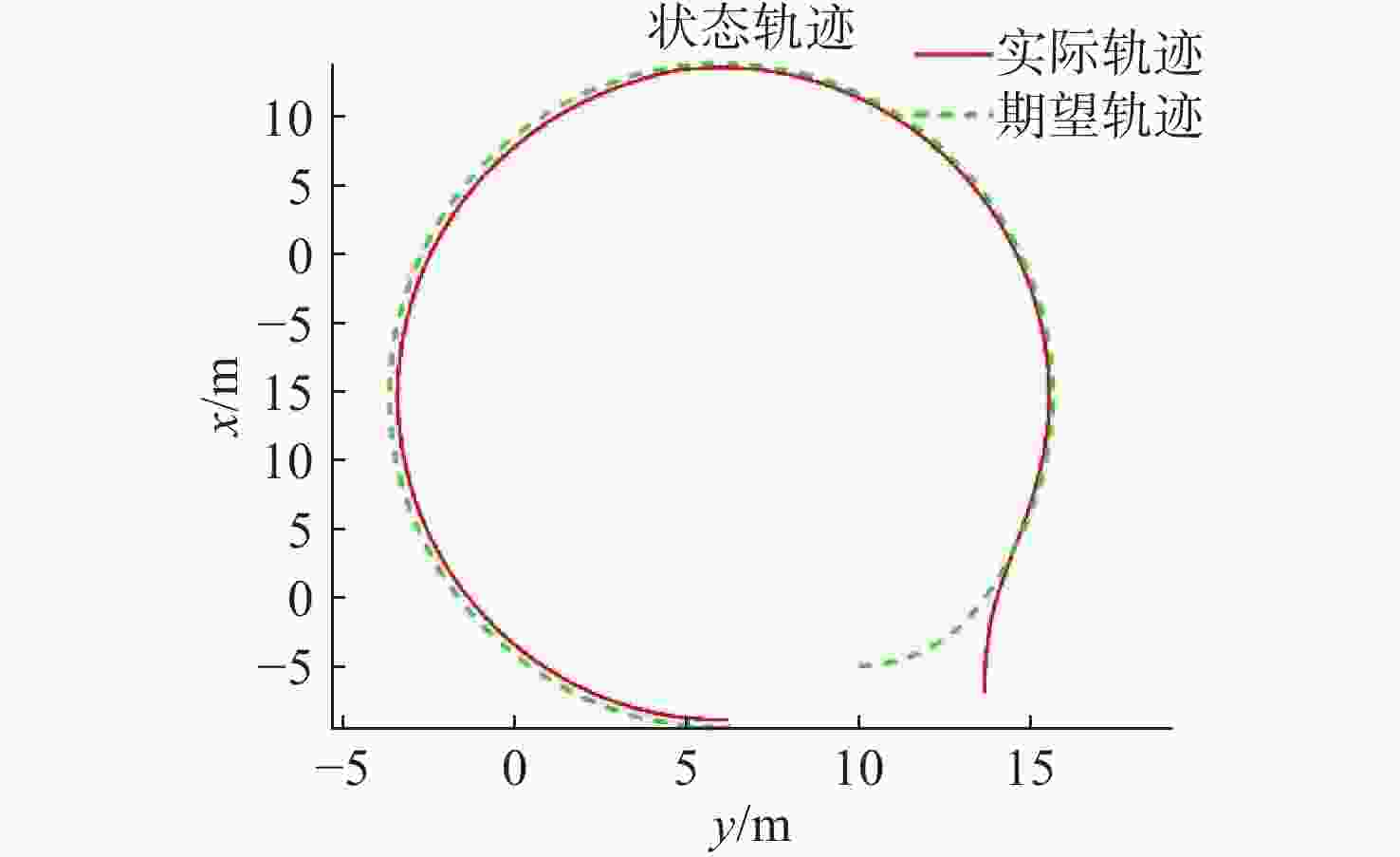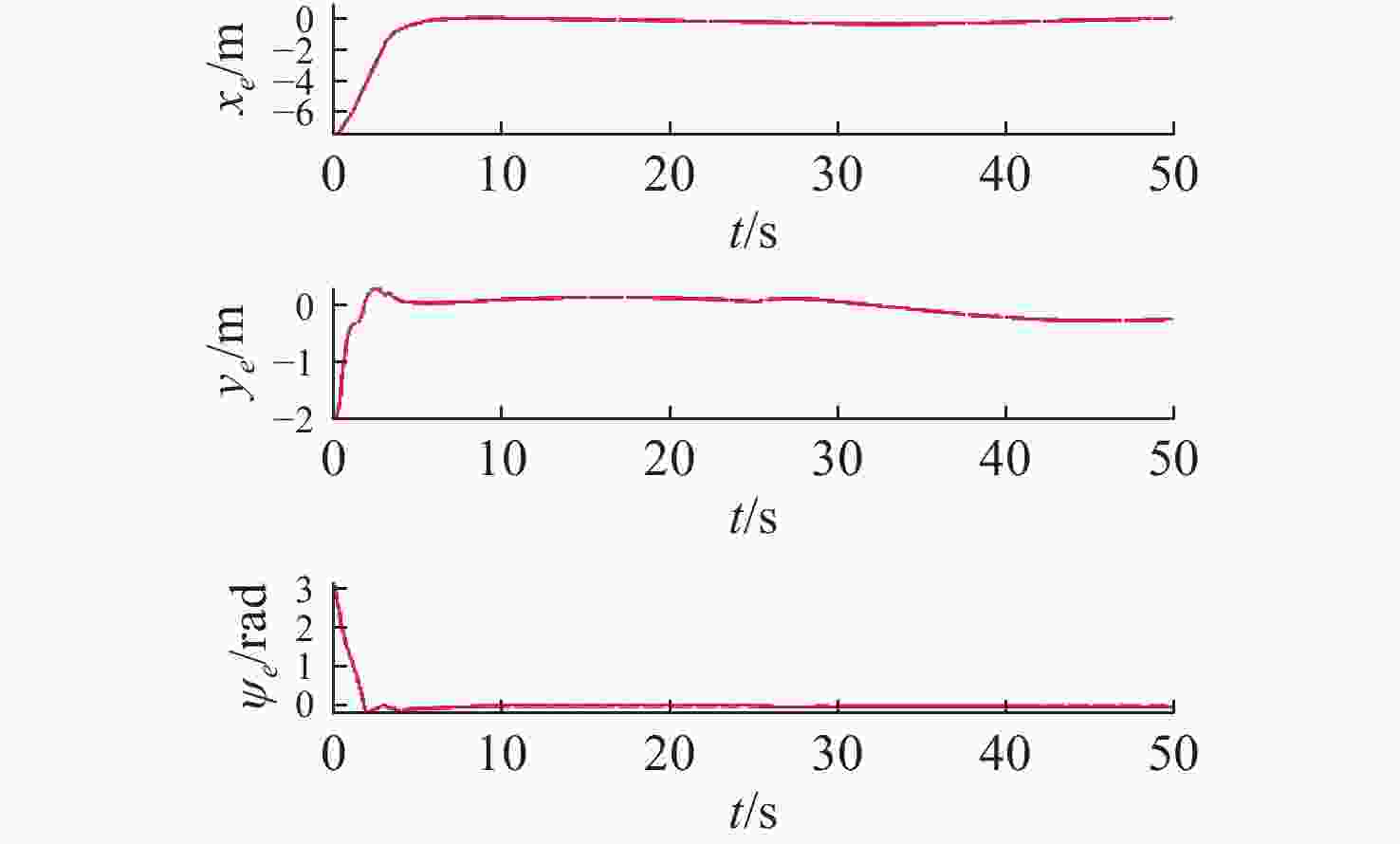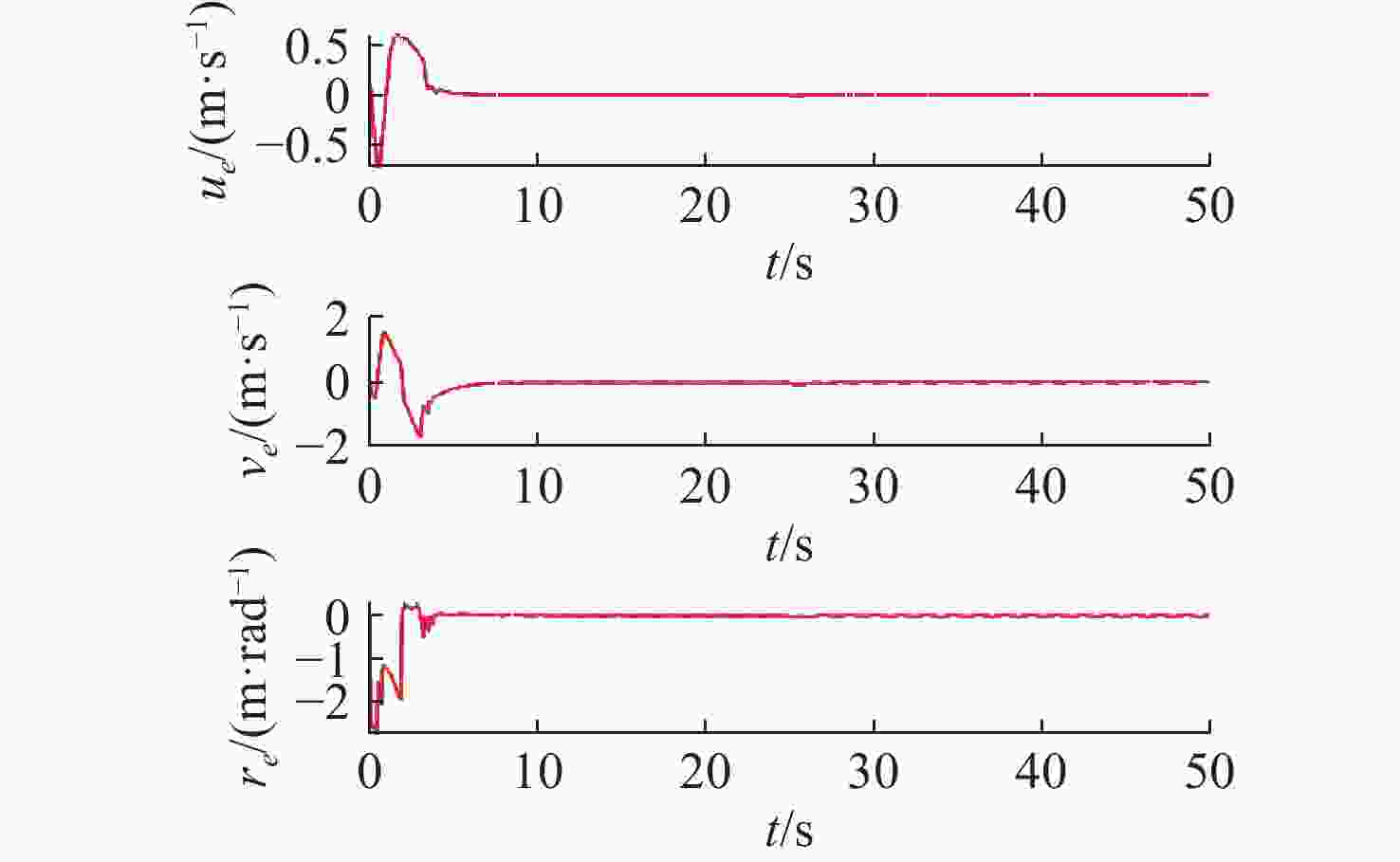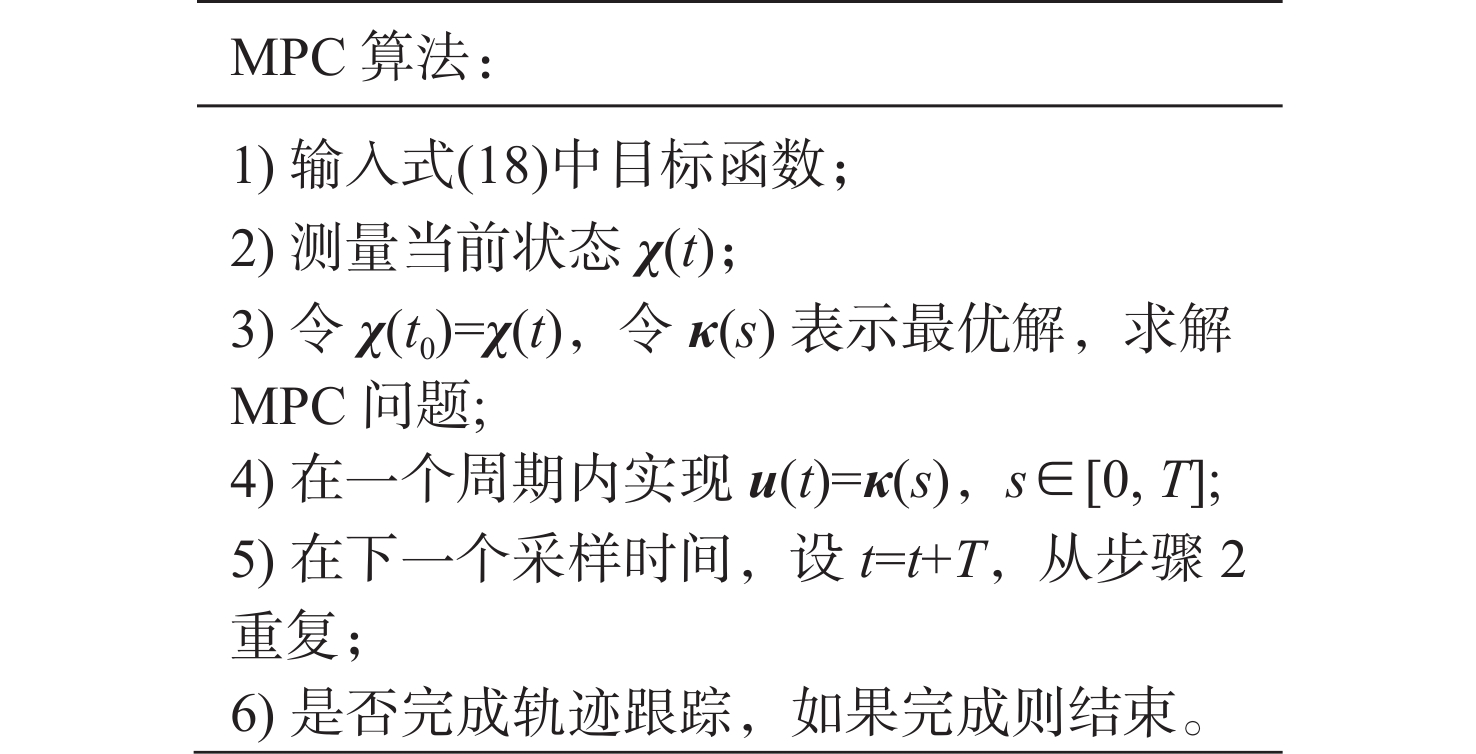Adaptive optimization control of unmanned surface vehicle with thruster fault
-
摘要: 针对带有推进器失效故障和动力学未知的无人艇自主控制问题, 提出一种基于模型预测控制的自适应容错控制方法。首先, 由于执行器发生部分失效故障, 建立含有故障的无人艇动力学模型; 将动力学模型中未知非线性动态和外部扰动形成集总非线性函数, 利用神经网络逼近动力学中未知部分; 为了实现对期望轨迹的高性能精确跟踪, 构造以控制输入和状态误差为变量的指标函数, 结合模型预测控制和反步控制设计了一种自适应自主容错控制策略; 基于李雅普诺夫稳定性理论证明了闭环系统内所有信号都有界, 在此框架下构建的控制策略既可以补偿执行器故障和未知非线性动态对系统造成的影响, 也可以保证系统的跟踪误差收敛到理想的精度。仿真结果验证了提出的方法的有效性和合理性。Abstract: In this paper, subject to both unknown dynamics and thruster fault, a novel adaptive model predictive-based fault-tolerant control (MPC-FTC) scheme is proposed for an unmanned surface vehicle(USV). To be specific, the dynamic model is re-established within unknown disturbances and failure fault. Neural network (NN) approximator is further deployed to adaptively identify complex unknowns and hydrodynamic parameters. In order to derive a practically optimal solution and high-precision tracking, simultaneously, the index function is constructed whereby control inputs and state errors. Model predictive control and backstepping control are combined to design an adaptive autonomous fault-tolerant control strategy. Eventually, theoretical analysis shows that the entire MPC-FTC scheme can render tracking errors that converge to an arbitrarily small neighborhood of the origin, subject to index function. Simulation results demonstrate remarkable effectiveness of the proposed MPC-FTC scheme.
-
表 1 Cybership II 水动力参数
Table 1. Cybership II hydrodynamic parameters
参数 取值 参数 取值 m 23.800/kg ${Y_r}$ 0.1079 /(N·s/m)${I_{\textit{z}}}$ 1.760/(kg·m2) ${N_v}$ 0.1052 /(N·s/m)${x_g}$ 0.046/m ${N_{\left| v \right|v}}$ 5.0437 /(N·s2/m2)${X_u}$ − 0.7225 /(N·s/m)${X_{\dot u}}$ −2.0/kg ${X_{\left| u \right|u}}$ − 1.3274 /(N·s2/m2)${Y_{\dot v}}$ −10.0/kg ${X_{uuu}}$ 1.255/(N·s3/m3) ${Y_{\dot r}}$ −0.0/(kg·m) ${Y_v}$ − 0.8612 /(N·s/m)${N_{\dot v}}$ −0.0/(kg·m) ${Y_{\left| v \right|v}}$ − 36.2823 /(N·s2/m)2${N_{\dot r}}$ −0.0/(kg·m2) -
[1] WANG N, GAO Y, ZHANG X. Data-driven performance-prescribed reinforcement learning control of an unmanned surface vehicle[J]. IEEE Transactions on Neural Networks and Learning Systems, 2021, 32(12): 5456-5467. doi: 10.1109/TNNLS.2021.3056444 [2] WANG N, GAO Y, YANG C, et al. Reinforcement learning-based finite-time tracking control of an unknown unmanned surface vehicle with input constraints[J]. Neurocomputing, 2022, 484: 26-37. doi: 10.1016/j.neucom.2021.04.133 [3] PENG G, LU Z Z, TAN Z J, et al. A novel algorithm based on nonlinear optimization for parameters calibration of wheeled robot mobile chasses[J]. Applied Mathematical Modelling, 2021, 95: 396-408. doi: 10.1016/j.apm.2021.02.012 [4] 王宁, 张雪峰, 李洁龙, 等. 面向港口环境精细感知的无人船多传感器融合SLAM系统[J]. 船舶工程, 2024, 46(7): 81-89.WANG N, ZHANG X F, LI J L, et al. Multi-Sensor fusion SLAM system of an unmanned surface vehicle for fine sensing in port environment[J]. Ship Engineering, 2024, 46(7): 81-89. [5] 王宁, 刘永金, 高颖. 未知扰动下的无人艇编队优化轨迹跟踪控制[J]. 中国舰船研究, 2024, 19(1): 178-190.WANG N, LIU Y J, GAO Y. Optimal trajectory tracking control of unmanned surface vehicle formation under unknown disturbances[J]. Chinese Journal of Ship Research, 2024, 19(1): 178-190. [6] ZHANG Y P, LIN Y J, WANG N. Reinforcement learning-based cooperative hunting for an unmanned surface vehicle swarm[C]//2024 International Conference on Fuzzy Theory and Its Applications (iFUZZY). Kagawa, Japan: IEEE, 2024, 01-06. [7] LIU C, FILARETOV V, ZUEV A, et al. Fault tolerant control in underwater vehicles[J]. Journal of Marine Science & Engineering, 2024, 12(10): 1836. [8] LI J P, FAN Y S, LIU J X. Adaptive NN formation tracking control for the multiple underactuated USVs with prescribed performance and input saturations[J]. Ocean Engineering, 2023, 290: 116274. doi: 10.1016/j.oceaneng.2023.116274 [9] SUN Y. Fault-tolerant control of multi-USV systems based on fuzzy systems[C]//The 14th International Conference on Information Science and Technology. Sichuan, China: IEEE, 2024, 237. [10] SUI B W, ZHANG J Q, LIU Z. Prescribed-time dynamic positioning control for USV with lumped disturbances, Thruster Saturation and Prescribed Performance Constraints[J]. Remote Sensing, 2024, 16(22): 4142. doi: 10.3390/rs16224142 [11] WANG Y, YANG X, HAO L Y, et al. Integral sliding mode output feedback control for unmanned marine vehicles using T–S fuzzy model with unknown premise variables and actuator faults[J]. Journal of Marine Science and Engineering, 2024, 12(6): 920. doi: 10.3390/jmse12060920 [12] ZHANG Y Y, ZHANG J Q, SUI B. Robust fixed-time adaptive fault-tolerant control for dynamic positioning of ships with thruster faults[J]. Applied Sciences, 2024, 14(13): 5738. doi: 10.3390/app14135738 [13] HAO L Y, ZHANG H, GUO G, et al. Quantized sliding mode control of unmanned marine vehicles: various thruster faults tolerated with a unified model[J]. IEEE Transactions on Systems, Man, and Cybernetics: Systems, 2021, 51(3): 2012-2026. [14] WANG N, DENG Z C. Finite-time fault estimator based fault-tolerance control for a surface vehicle with input saturations[J]. IEEE Transactions on Industrial Informatics, 2019, 16(2): 1172-1181. [15] CHRISTOFIDES P D, LIU J, DE L P D M. Networked and distributed predictive control: methods and nonlinear process network applications[M]. Springer Science & Business Media, 2011. [16] KHALIL H K. Nonlinear systems. [M]New York: USA: Prentice-Hall, 1996. -





 下载:
下载:











